Sample information |
|
| Picture |
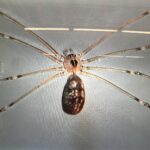
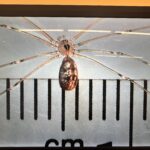
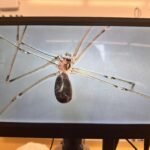
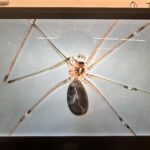
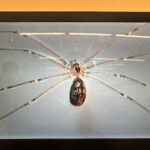
|
|---|---|
| Location | |
| Collection date | 02/20/2025 |
| Captive / Cultivated? | Wild-caught |
| Group | Berkshire Community College |
| Observations | Specimen was found by active collection inside a home in Pittsfield, Massachusetts. It was spotted in the ceiling corners of a foyer on February 20th of 2025 at approximately 7:00 A.M. EST. ELMS1 was collected by hand into a collection tube. Specimen was captured alive and placed in a freezer for 15 minutes, then transferred to Berkshire Community College to be stored in the freezer again at 9:30 A.M. EST. By 11:00 A.M. EST., the specimen was removed from the freezer and photographed with a cellular device on a petri dish through a digital screen on a dissecting scope at 8x magnification. After all photographs were taken, ELMS1 was placed into a 2 ml tube labeled accordingly and filled with isopropyl alcohol. ELMS1 was then finally stored in a 0 degrees celsius freezer for preservation until the DNA extraction. |
| Putative identification | Arthropoda Arachnida Araneae Pholcidae Pholcus Pholcus phalangioides |
Methods |
|
| Extraction kit | Monarch DNA extraction (NEB) |
| DNA extraction location | Whole arthropod |
| Single or Duplex PCR | Single Reaction |
| Gel electrophoresis system | Standard electrophoresis system |
| Buffer | TAE |
| DNA stain | SYBR Safe |
| Gel images |
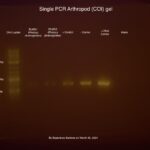
|
| Protocol notes | A single PCR (ELMSPCR1) was done on ELMS1 and ELMS2 (separate data entry for specimen ELMS2 but all testing, extractions, and PCRs were done together) in order to find the Arthropod Barcoding Gene (CO1) on March 26, 2025. The expected band size was 708bp with an annealing temperature of 49 degrees celsius. The taq polymerase used was NEB OneTaq Hot Start Quick-Load 2x MM w/ Stand. Buffer (M0488S). The DNA Ladder used was NEB 1 kb Plus DNA Ladder for Safe Stains (product # N0559S). Primes used to amplify a 708-bp fragment of the CO1 gene were Arthropod_F (LCO1490) and Arthropod_R (HCO2198). Images of the PCR are attached above labeled, “Single PCR Arthropod CO1 (ELMSPCR1).” A single PCR (ELMSPCR2) was done on ELMS1 and ELMS2 (separate data entry for specimen ELMS2 but all testing, extractions, and PCRs were done together) in order to find the Wolbachia Specific Gene (16S rRNA) on March 27, 2025. The expected band size was 438bp with an annealing temperature of 55 degrees celsius. The taq polymerase used was NEB OneTaq Hot Start Quick-Load 2x MM w/ Stand. Buffer (M0488S). The DNA Ladder used was NEB 1 kb Plus DNA Ladder for Safe Stains (product # N0559S). Primers to specifically amplify a 438-bp fragment of the 16S rRNA gene were Wolbachia_F (16S_WspecF) and Wolbachia_R (16S_WspecR). Images of the PCR are attached above labeled, “Single PCR Wolbachia 16S (ELMSPCR2).” |
Results |
|
| Wolbachia presence | No |
| Confidence level | Medium |
| Explanation of confidence level | I am moderately confident that my species are arthropods and are negative for Wolbachia. The positive and negative controls such as the arthropod controls, dna controls, and water control – all showed proper bandage across both PCRs to support my conclusion. I am not highly confident of either PCR because of the faint bands in ELMSPCR1 which could indicate a false negative in ELMSPCR2. With proper time and equipment, PCRs could be redone and a more confident conclusion could be made. As of now with the information at hand, both Pholcus phalangioides most likely have the Arthropod CO1 gene and are negative for the presence of Wolbachia 16S gene. |
| Wolbachia 16S sequence | |
| Arthropod COI sequence | Download AB1
NNNTTNNNANNNNNNATCTNCTATAGTAGGTACTGCTTTAAGAGTGATTATTCNAGTGGAGTTAGGACAAGGAGGAAGAT TTTTAGGGGATGATCATTTATATAATGTTGTAGTAACTGCTCATGCGTTAATTATGATTTTTTTTATAGTTATGCCTATT TTAATTGGGGGGTTTGGAAATTGATTAGTTCCTTTAATGTTGGGGGCTCCAGATATAGCTTTTCCTCGTATAAATAATTT AAGATTTTGGCTTCTTCCTCCTGCTATTATGCTTTTATTATTATCTGGTCTTGTAAAAACTGGAGTTGGAGCAGGATGAA CTATTTATCCTCCTTTATCATCTANAGTAGGGCATAGAGGGGTTTCCATAGATTTTGCTATTTTTTCTCTTCATTTAGCG GGGGCTTCANCNATTATAGGAGCTATTAATTTTATTTCTACAGTTGTTAATATACGATTAATTGGAGTGAGAATGGATAA AGTGAGATTGTTTGTTTGATCTGTATTAATTACTGCTGTTCTTTTACTTCTTTCTTTACCTGTTTTAGCTGGTGCTATTA NNATACNTTTGACTGATCGNAATTTTAATACTGCCNTTTTTTTGACCCTGCTGGAGGANGGGATCCAATCTTGNTTCNAC ATCTTTTTTCNGANTTTTTTGNTNNNCCCTGAAATTTNAANNN
BLAST at The Wolbachia Project BLAST at NCBI
|
| Summary | The Pholcus phalangioides was found to be negative for Wolbachia. |
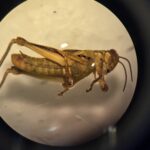 Differential Grasshopper – Melanoplus differentialis
Differential Grasshopper – Melanoplus differentialis Pill Bug (Armadillidium vulgare) – Draft
Pill Bug (Armadillidium vulgare) – Draft Melanoplus Femurrubrum
Melanoplus Femurrubrum Grasshopper – Orthoptera
Grasshopper – Orthoptera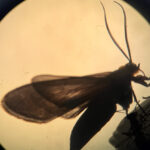 Cisseps Fulvicollis
Cisseps Fulvicollis